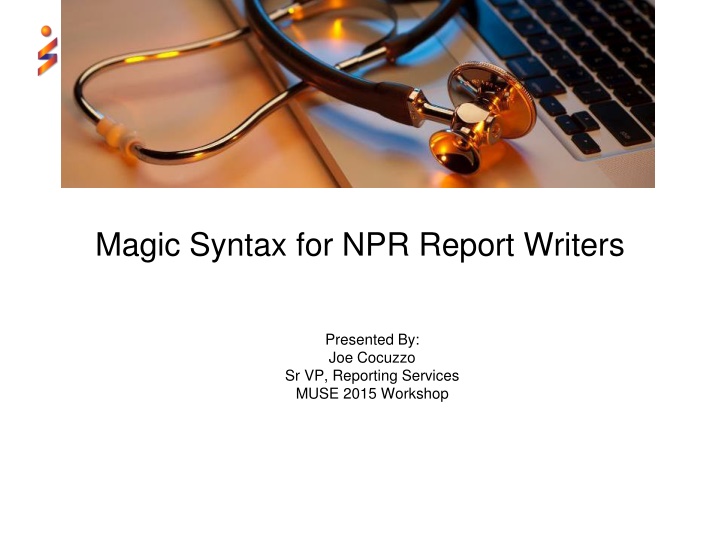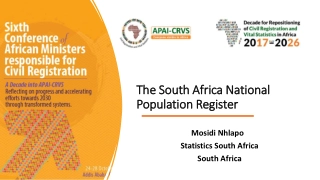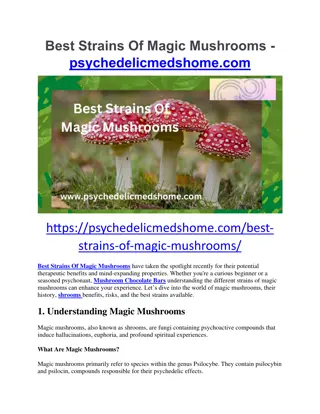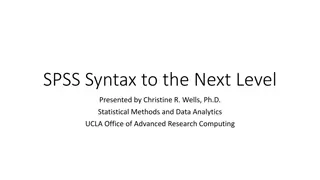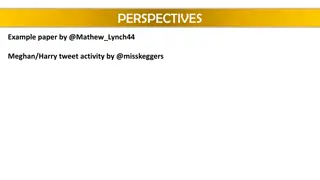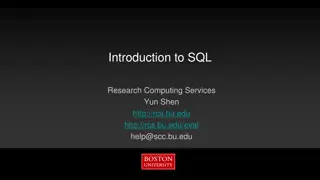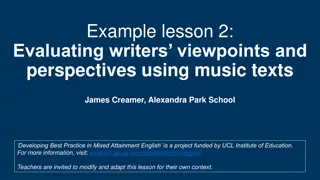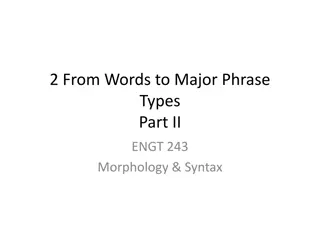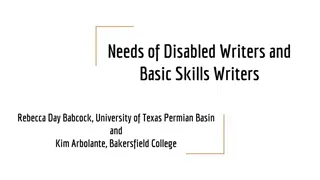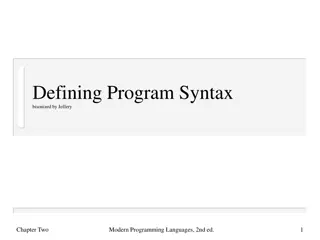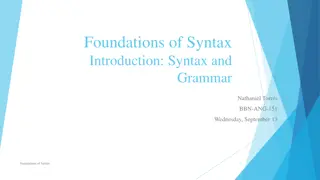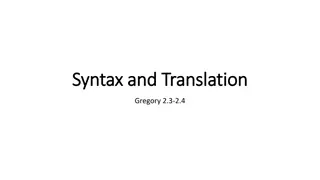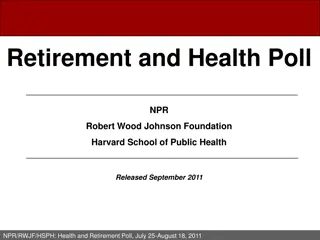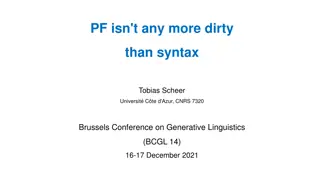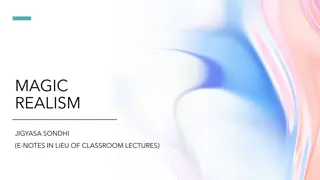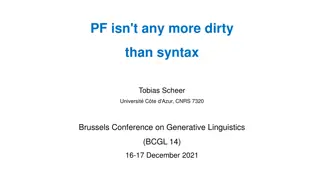Magic Syntax for NPR Report Writers
Learn about Magic, a proprietary lightweight language derived from MUMPS, designed for string data, particularly popular in medical applications like Sunquest and Cerner. Discover how Magic offers unique features like left-to-right evaluation and automatic data storage in trees.
Download Presentation

Please find below an Image/Link to download the presentation.
The content on the website is provided AS IS for your information and personal use only. It may not be sold, licensed, or shared on other websites without obtaining consent from the author.If you encounter any issues during the download, it is possible that the publisher has removed the file from their server.
You are allowed to download the files provided on this website for personal or commercial use, subject to the condition that they are used lawfully. All files are the property of their respective owners.
The content on the website is provided AS IS for your information and personal use only. It may not be sold, licensed, or shared on other websites without obtaining consent from the author.
E N D
Presentation Transcript
Magic Syntax for NPR Report Writers Presented By: Joe Cocuzzo Sr VP, Reporting Services MUSE 2015 Workshop
About Magic Proprietary offshoot of MUMPS (a/k/a M ) Developed by Dr Octo Barnet with help from A. Neil Papalardo at Mass General. Designed to be a lightweight language particularly suited for string (text) data. Popular for Medical applications: Sunquest, Cerner, IDX, EPIC 2
Meditech Now in Four Flavors Magic - Proprietary OS / Magic Language C/S - Windows OS / Magic Language a/k/a VMagic FS - Functional System (C/S platform, EMR & PCS) FOCUS - M/AT 6.x 6.0EMR, ER PCS, POM, OE move to FS w/ toolset PCS data NOT returned to C/S. 6.1 financials and administratives move also 3
New Tools.. New Focus Report Designer (RD) Goals.. no code required Achievement.. no coding allowed! Reports from FOCUS and C/S applications. C/S Vmagic can get data from FOCUS w/ some complicated programming 4
Fundamentals of Magic LEFT to RIGHT evaluation Everything is a string Value = True No Value (nil) = False Powerful string operators (like MUMPS) Weak math skills 10+2*5= 60 (!) 5/10 = 0 (!) 5
Fundamentals - Continued Data automatically stored in tree Global Subscript *AA[aa] = data Prefix Data automatically sorted by subscripts No need for searching or sorting algorithms 6
More Fundamentals (weaknesses) Variable name + string < 256 in length Lines of code < 256 in length (Magic Only) 1K for variables and their values across all programs in session unless you stack symbol table
Symbol Table In Magic.. 1024 bytes is all you get Unless.. %ADM.PAT.zcus.is.your.macro.M.do(urn)X You get space back when you nil a variable
Symbol Table continued Symbol table limit applies to local variables only: STUFF, x, y, aa Not to slash variables /STUFF b.dis.date e.dis.date @.user b.dis.date translates to /b.discharge.date @.user translates to /.USR
FILES Sequential Access Files vs Random Access Files SAF Spool File, RAD editor text file RAF All data and dictionary files MUSE 2015 NPR Tips and Tricks 10
Look at Data 11
What are these: Data is packed or queued
How to make these yourself? Q( FIRST , SECOND , THIRD )^STUFF STUFF|0 = FIRST STUFF|1 = SECOND STUFF|2 = THIRD
Alternative Syntax { FIRST , SECOND , THIRD }^STUFF THIRD ^STUFF|2 Add quotes automatically.. `FIRST,SECOND,THIRD ^STUFF
Get data back out STUFF = FIRST^SECOND^THIRD STUFF|0=FIRST STUFF|1=SECOND STUFF|2=THIRD STUFF^{A,B,C} A=FIRST, B=SECOND, C=THIRD
So.. Magic is an easy language 1) String operators 2) IF syntax 3) @Next, @Prev, + and 4) DO syntax ----------------- Magic Prefix management/Looping C/S Opening Database/Looping 16
String Operators # string at the position ABC#1 = B $ to the left YYYYMMDD$4= YYYY % to the right YYYYMMDD%5 = DD = not ABC #1 = AC 17
String Operators YOURSTRING 0123456789 YOURSTRING#3 = R YOURSTRING%3$3 = STR YOURSTRING #3 = YOUSTRING MUSE 2015 Magic Syntax 18
What is it good for? ER admissions by hour of the day: xx.hour DAT=INT LEN=2 VAL=@service.time$2+0 19
Parsing Strings invented delimiter BERMAN,JOEL F # 0, = BERMAN BERMAN,JOEL F # 1, = JOEL F BERMAN,JOEL F # 1, # 0<space> = JOEL 20
Parse Mnemonics Mnemonics: NUR.COCJ# 0, = NUR IS.SMIF# 0. = IS PURC.JOE# 0. = PURC 21
Strip SSN of dashes NNN-NN-NNNN #3 #5 NNN-NN-NNNN #3 = NNNNN-NNNN 01234567890 NNNNN-NNNN #5 0123456789 ( ~ for general stripping) 22
Magic Math Left to Right no precedence of operation Decimal Precision: + - * places = operand w/ most places / decimal places in numerator places in denominator: 5/10 = 0 (zero places zero places = zero) 5.0/10 = 0.5 (1 place zero places = 1 place) 23
Magic Math Rule Of Thumb X * 1.00000000000/Y :2D Give X lots of places, then round with :nD n = desired number of places with 5/4 rounding 24
More punctuation : : = format operator :nD = round to n decimals :nT = truncate to n characters :nTL = truncate to n characters, left pad :nTR = truncate to n characters, right pad For zero padding: %Z.zero.fill() see your mouse pad for details 25
Lost your mouse pad.. Look at MT source code: Magic F(4) \Name of Program C/S F(5) DPM, then procedure Lookup available Arguments usually at top of program 26
Copy MT Macros INIT report from standard.. The more you need it, the less likely it is to work List report to paper Create report w/ same selects/segments Copy Macros w/ F(4) Magic Exact name match needed in Magic F(5) C/S Put M at procedure prompt in C/S 27
Syntax issues Take @ sign out of @Next subscripts DO{@Next(@dx) change to @Next(dx) Loop instead of Killing K(/STUFF) @Kill(/STUFF) $K(^/STUFF) DO{>/STUFF[SUB]^SUB ^/STUFF[SUB]} 28
Syntax issues continued Writing to @ 141^@Z.last.key Change to 141^/Z Writing to /. 1^@.pha.site ".PHA.SITE"^XXX, 1^/[XXX] 29
IF syntax IF{condition<space>statement} IF{condition<space>statement; Nextcond<space>statement; Nextcond<space>statement; Finalvalue} 30
IF Syntax IF{@age.in.years^AGE<18 "Child"; AGE<65 "Adult"; AGE "Senior"; "No Age Available"} 31
Things that mess up IF Left hand value returned if comparison is true Nil returned if comparison is false Forgetting LEFT TO RIGHT (!) Not knowing that: ! = maximum (not really OR) & = minimum (not really AND) 32
IF failure IF{@age.in.years^AGE<18!AGE>65 "Y"} IF{17<18!17>65 "Y"} IF{17!17 returns 17 IF{17>65 "Y"} fails Solution: Add Parenthesis IF{@age.years^AGE<18!(AGE>65) "Y"} 33
+ and - + = most essential operator in Magic Moves thru structures one subscript level at a time List next doctor (or first if DOC var is initially nil) +\GU[DOC]^DOC 34
Sense of + + pushes subscript into variable Value of this expression goes from first doctor to last doctor, then to nil +\GU[DOC]^DOC 35
Add A Do Combine + and DO and you have a report writer DO{+\GU[DOC]^DOC N(DOC)^#} 36
Syntax of DO DO{while.true<space>DOSTUFF} So list Doctors from start to "C" DO{+\GU[DOC]^DOC<"D" N(DOC)^#} 37
Report Example List LI vals Loop on c.inpatient.location, build list of locations in string and print on report ADM.PAT.zcus.is.muse2015.loop.on.location 38
@Next Difference between + and @Next @Next is for structures in the Data Definition @Next(dx) @Next(room,@room.bed.index) 39
@Next @Next uses data definition to figure out the subscripts and structure to loop on: @Next(dx) +?DZ[dz]DX[dxN]^dxN @Next(bed,@room.bed.index) +:AARB[ggb,ggrB]^ggrB] @Next(subscript) or @Next(subscript,index) 40
Report Example Scheduled and Registered Patients on Same Report Loop on Registration Index AND Loop on Scheduled Index "yourself" Put urns into list in slash ADM.PAT.zcus.is.muse2015.sch.and.reg 41
Next Get syntax +(/STUFF[SUB],DATA)^SUB + on subscript and get value of node in one operation @Next.get(bed,@room.bed.index,urn)
Report Example Current Patients on NUR Report Bonus Skip Undo Post Edit Values Only MUSE 2007 NPR Tips and Tricks 43
Physical Next/ Physical Previous >:AARB[SUB]^SUB >@room.bed.index[SUB]^SUB SUB#0S = facility SUB#1S = room SUB#1S = bed You can use > in Next Get syntax >(@room.bed.index[SUB],DATA)^SUB
Physical Nexting There is also physical previous (<) No translator operator for > and < ie nothing like: @Phys.Next(STUFF)
